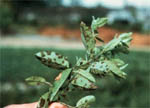Reports on Plant Diseases |
RPD No. 638 - Firethorn (Pyracantha) Scab
|
March 2000
|
[ Symptoms ] [ Disease Cycle
] [ Control ]
|
Scab is a widespread and unsightly disease of the commonly grown shrub
firethorn, or Pyracantha. The disease, caused by the fungus Spilocaea
pyracanthae, affects the brilliantly colored orange-red fruits as
well as the leaves and stems. It is most likely to occur when spring and
summer weather is cool and moist.
Symptoms
Scab appears as velvety, sootlike areas on the shiny green leaves (Figure
1). Affected leaves first turn yellow and then dark brown, and they finally
drop prematurely. Black lesions may also form on the newly elongated twig
growth and cause girdling and twig dieback. When young fruits are infected,
they shrivel and fail to mature. If infection occurs on older, more mature
fruit, the brilliant orange-red color turns black and the skin becomes
rough, scabby, and unsightly (Figure 2). The blackening of the fruit is
the most serious symptom of the disease.
Back to Top
|
Click on images
for larger versions

Figure 1.
Pyracantha scab on leaves in home nursery.

Figure 2.
Scab infection on ripe orange berries.
|
Disease Cycle
The scab fungus overwinters in and on diseased stems, affected fruits, and
leaves that remain attached. In spring and early summer, large numbers of microscopic
spores (conidia) are formed on the diseased plant parts. The conidia are disseminated
mostly by splashing water. Germination of the spores, penetration of host tissues,
and disease development occur when the host plant is covered with a film of
moisture, such as might be produced by heavy dews or prolonged light rains.
Back to Top
Control
-
Grow adapted, scab-resistant firethorn cultivars. Most firethorn cultivars
are adapted to USDA hardiness zones 6 and higher (average annual minimum
temperature is -10° F or warmer). However, very hardy cultivars are
able to survive into zone 5 (-20° to-10° F). Thus, the southern
half of Illinois, or protected areas elsewhere in the state, are best suited
for growing firethorn. According to Michael Dirr (Manual of Woody Landscape
Plants: Their Identification, Ornamental Characteristics, Culture, Propagation,
and uses), the cultivars Apache, Fiery Cascade, Rutgers, and Teton have
resistance to scab and fireblight and should be hardy in the southern half
of Illinois (or protected areas elsewhere in the state). Avoid the scab-susceptible
cultivars Kasan, Lalandei, Lalandei Monrovia, Thornless, Wyattii, and Gnome.
As always, check with your nearest University of Illinois Extension Educator
and garden centers for information about which cultivars are best suited
for your particular area.
-
Collect and burn or haul away with the trash all diseased parts during
the autumn or winter. Sanitation helps to eliminate overwintering sources
of inoculum but will not adequately control the disease.
- In addition to growing resistant cultivars and practicing sanitation, apply
one of the fungicides suggested in the Illinois Commercial Landscape and Turfgrass
Pest Management Handbook or Illinois Homeowner’s Guide to Pest Management.
Thoroughly spray all aboveground parts of each plant, including both surfaces
of the leaves. Start as the buds break open in the spring, and continue until
about two weeks after the flower petals fall.
The fungicide must be present on the leaves, stems, and fruit prior to rainfall
to provide maximum protection from spores that are distributed by splashing
water. Spray to the point of runoff (plants begin to drip). When spraying
the hard-to-wet leaves, stems, and fruits, add a small amount of a commercial
spreader-sticker (surfactant) if your preparation does not already contain
a surfactant. Follow the directions on the container label.
Back to Top
For further information concerning diseases of ornamental
plants, contact Nancy R. Pataky, Extension Specialist and Director of the Plant
Disease Clinic, Department of Crop Sciences, University of Illinois, Urbana-Champaign.
University of Illinois Extension provides equal
opportunities in programs and employment.
|



